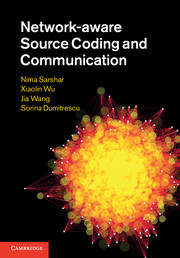Book contents
- Frontmatter
- Contents
- 1 Introduction
- Part I The lossless scenario
- Part II The lossy scenario
- 5 Lossy source communication: an approach based on multiple-description codes
- 6 Solving the rainbow network flow problem
- 7 Continuous rainbow network flow: rainbow network flow with unbounded delay
- 8 Practical methods for MDC design
- 9 Using progressive codes for lossy source communication
- 10 Lossy communication of multiple correlated sources
- References
- Index
6 - Solving the rainbow network flow problem
from Part II - The lossy scenario
Published online by Cambridge University Press: 07 October 2011
- Frontmatter
- Contents
- 1 Introduction
- Part I The lossless scenario
- Part II The lossy scenario
- 5 Lossy source communication: an approach based on multiple-description codes
- 6 Solving the rainbow network flow problem
- 7 Continuous rainbow network flow: rainbow network flow with unbounded delay
- 8 Practical methods for MDC design
- 9 Using progressive codes for lossy source communication
- 10 Lossy communication of multiple correlated sources
- References
- Index
Summary
The methods proposed in the previous chapter rely on our ability to find a, perhaps approximate, solution to the RNF problem, and in particular the CRNF problem. Once such a solution is found, the design of the MDC codes with PET technique is straightforward. This chapter is a more detailed algorithmic account of RNF and in particular the CRNF problem.
We start by proving the CRNF problem to be NP-Hard in Section 6.1, even on Directed Acyclic Graph (DAG) network topologies. In Section 6.2, we show that the CRNF problem can be posed as an integer linear program for DAGs. The problem can therefore be solved for moderate network sizes using existing numerical optimization packages.
For large networks, the results in Section 6.1 suggest that the exact solution to the linear integer program formulated in Section 6.2 can not be found efficiently. While the CRNF problem is NP-Hard even on DAGs, we find a polynomial-time solution for a generalized tree topology. If the network graph can be appropriately decomposed into tree components, then a dynamic programming algorithm can be applied to solve the CRNF problem exactly for a general distortion function δ(k). The development of this algorithm is the subject of Section 6.3.
Complexity results of the CRNF problem
In this section, we prove that the CRNF problem is NP-Hard. The proof is constructed by reducing the well-known NP-hard problem of graph 3-colorability [42] to a special instance of CRNF on a DAG, where there is only a single server node.
- Type
- Chapter
- Information
- Network-aware Source Coding and Communication , pp. 59 - 70Publisher: Cambridge University PressPrint publication year: 2011



